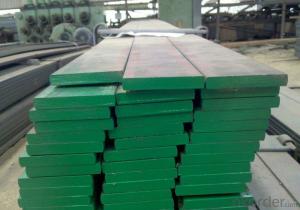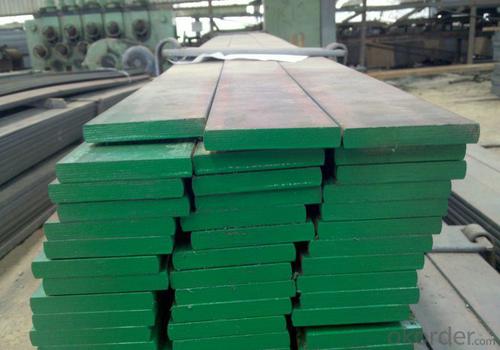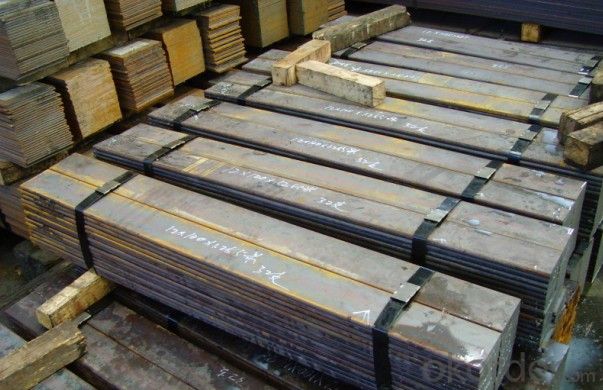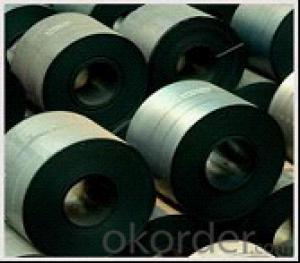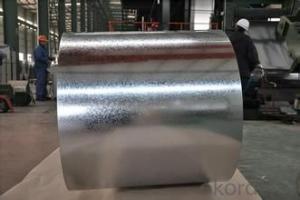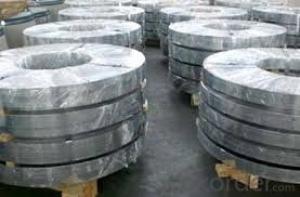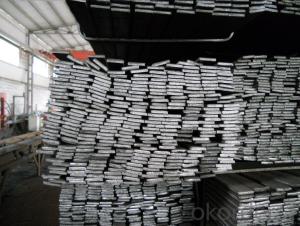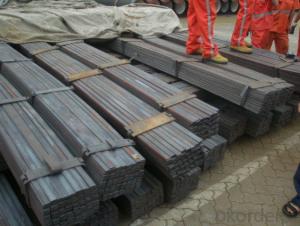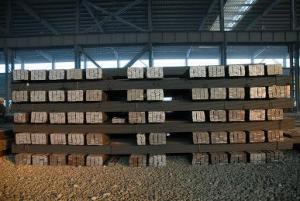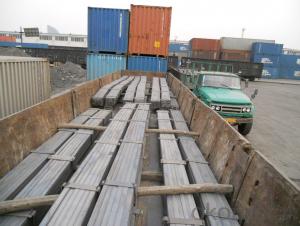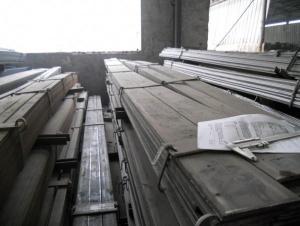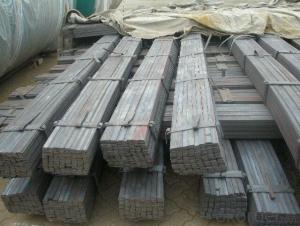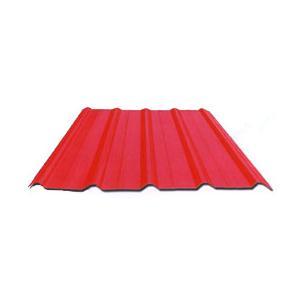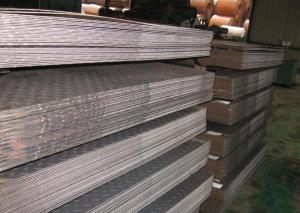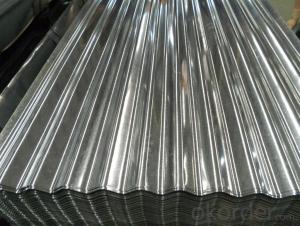Hot Rolled Alloy Leaf Spring Flat Bar
- Loading Port:
- Qingdao
- Payment Terms:
- TT OR LC
- Min Order Qty:
- 2000 PCS
- Supply Capability:
- 38000 PCS/month
OKorder Service Pledge
OKorder Financial Service
You Might Also Like
Hot Rolled Alloy Leaf Spring Flat Bar Details
| Grade: | SUP9,SUP6, SUP7,SUP9 | Standard: | AISI,ASTM,BS,DIN, GB,JIS,JIS G48001:2005 | Thickness: | 10CM |
| Width: | 70CM | Length: | 5800CM,5800mm | Place of Origin: | China (Mainland) |
| Brand Name: | DaQiang | Model Number: | sup9 | Application: | leaf spring making |
| Technique: | Hot Rolled | Special Use: | Mold Steel | Surface: | Plain or double grooved |
| Tolerance: | standard | Packing: | steel strip with 5-7 times | MTC: | offered |
| Bundle weight: | about 2 tons | Raw Material: | hot rolled spring steel flat bar |
Packaging & Delivery
| Packaging Detail: | Export packing : in bundles,packed with 5 clamps along the bundles ,including two clamps in 1.5 meters each head ,three clamps in the middle of bundle .20-25 ton for each 20' container , each bundle weight about 2 tons. |
| Delivery Detail: | 20 days after receiving your deposits, or workable L/C. |
Hot Rolled Alloy Leaf Spring Flat Bar Advantages
1)Authorized Certificates : ISO9001, SGS,BV
2) Day Capacity: 4000tons per day
3) 22 years production experience
4) More than 40000 Tons stock
5) More than 3000 Tons sold per day
Hot Rolled Alloy Leaf Spring Flat Bar Pictures



Hot Rolled Alloy Leaf Spring Flat Bar Specification
Hot rolled spring steel flat bar | ||||
Size | Thickness | 5-45mm | ||
Width | 45-180mm | |||
Length | 5800mm | |||
Samples free for charge | ||||
Packing | In bundle | |||
Bundle Weight | About 2tons | |||
MOQ | 10tons each size | |||
Delivery Time | 20 days after receiving your deposits, or workable L/C. | |||
Payment | 100% Irrevocable documentary L/C at sight ; or 30% deposit in advance and the balance against copy B/L within 3 days . | |||
Application: | Leaf spring | Tools, Blade | ||
SUP9 flat bar | 28MnCrB5, 30MnCrB5 | |||
Main Market: | Asia | Vietnam,Thailand,Myanmar,Malaysia,Indonesia,Philippines,South Korea,India, Bangladesh,Sri Lanka | ||
Latin America | Venezuela, Chile, Colombia, panama, Mexico, Brazil, Peru | |||
Middle East | Iran,Lebanon, Syria | |||
Africa | Egypt, Kenya, Tunisia | |||
European | Spain | |||
- Q: Do steel sheets have any magnetic properties?
- Indeed, magnetic properties are possessed by steel sheets. Steel, which is an alloy primarily composed of iron, carbon, and other elements, exhibits ferromagnetism. This characteristic enables it to be magnetized and attract magnets. Nevertheless, the extent of magnetism in steel can differ based on its composition and processing. Certain steel alloys can be effortlessly magnetized and retain their magnetism even after the removal of the applied magnetic field, while others may display lower magnetic properties. Furthermore, the presence of impurities and the specific heat treatment process can also impact the magnetic properties of steel. In summary, steel sheets can display magnetic properties; however, the degree of magnetism may fluctuate depending on the specific type and composition of the steel.
- Q: What is the difference between zinc-coated and zinc-aluminum coated steel sheets?
- Zinc-coated and zinc-aluminum coated steel sheets are two types of steel that have undergone zinc treatment for protection. However, there are differences between the two processes that result in varying characteristics and performance. Galvanized steel sheets, also known as zinc-coated steel sheets, are made by immersing the steel sheets in molten zinc. This creates a layer of pure zinc on the steel's surface, forming a barrier against corrosion. The zinc layer is typically evenly applied across the entire sheet. On the other hand, galvalume or Aluzinc steel sheets, which are zinc-aluminum coated, are created by coating the steel sheets with a mixture of zinc and aluminum. This coating is applied using a hot-dip process, similar to the one used for zinc-coated steel sheets. The aluminum in the coating enhances corrosion resistance compared to pure zinc coatings. The main difference between zinc-coated and zinc-aluminum coated steel sheets lies in their performance and durability. Zinc-coated sheets effectively protect against corrosion in most atmospheric environments. However, in more aggressive or severe environments, such as high humidity or exposure to saltwater, zinc-coated steel may not provide sufficient protection and can corrode over time. In contrast, zinc-aluminum coated steel sheets offer superior corrosion resistance due to the presence of aluminum in the coating. The aluminum acts as a sacrificial anode, corroding preferentially to the steel and safeguarding it from corrosion. This makes zinc-aluminum coated sheets more suitable for environments with significant corrosion concerns, such as coastal areas or industrial settings. In conclusion, while both zinc-coated and zinc-aluminum coated steel sheets provide a protective zinc layer, zinc-aluminum coated sheets offer improved corrosion resistance due to the inclusion of aluminum. Therefore, zinc-aluminum coated steel sheets are generally preferred in aggressive or corrosive environments, while zinc-coated steel sheets are suitable for most atmospheric conditions.
- Q: Are steel sheets suitable for HVAC ductwork?
- Yes, steel sheets are suitable for HVAC ductwork. Steel is a durable and strong material that can withstand the pressure and temperature changes associated with HVAC systems. It is also resistant to corrosion and leakage, making it an ideal choice for ductwork applications. Additionally, steel sheets can be easily fabricated and installed, ensuring a reliable and efficient HVAC system.
- Q: What is the process of electroplating steel sheets?
- Electroplating steel sheets involves immersing them in an electrolyte solution, typically containing metal ions, and applying an electric current. The steel sheets act as the cathode, attracting the metal ions from the electrolyte onto their surface, forming a thin layer of the desired metal. This process helps enhance the steel sheets' corrosion resistance, appearance, and other properties.
- Q: What is the typical load-bearing capacity of a steel sheet?
- The typical load-bearing capacity of a steel sheet can vary depending on its thickness, grade of steel, and how it is supported. However, on average, a standard steel sheet can typically bear loads ranging from 5,000 to 20,000 pounds per square inch.
- Q: What are the different types of steel sheets available?
- There are various types of steel sheets available, including hot rolled, cold rolled, galvanized, stainless, and coated steel sheets.
- Q: Are steel sheets suitable for interior ceiling panels?
- Yes, steel sheets are suitable for interior ceiling panels. They are durable, fire-resistant, and can provide a modern and sleek appearance to any space. Additionally, steel sheets are easy to clean and maintain, making them a practical choice for interior ceiling applications.
- Q: Can steel sheets be used for elevator doors?
- Yes, steel sheets can be used for elevator doors. Steel is a commonly used material for elevator doors due to its strength, durability, and fire-resistant properties.
- Q: Can steel sheets be used for reinforcing concrete structures?
- Yes, steel sheets can be used for reinforcing concrete structures. Steel sheets, commonly referred to as steel plates or steel mesh, are often used as reinforcement in concrete structures to enhance their tensile strength and durability. The steel sheets are typically placed within the concrete to provide additional support, preventing cracking and increasing the overall structural integrity of the concrete.
- Q: Can steel sheets be used for architectural purposes?
- Yes, steel sheets can be used for architectural purposes. They are often utilized in construction projects for their durability, strength, and versatility. Steel sheets can be used for roofing, cladding, facades, and structural applications, providing a modern and sleek aesthetic while also offering structural integrity and resistance to weather conditions.
Send your message to us
Hot Rolled Alloy Leaf Spring Flat Bar
- Loading Port:
- Qingdao
- Payment Terms:
- TT OR LC
- Min Order Qty:
- 2000 PCS
- Supply Capability:
- 38000 PCS/month
OKorder Service Pledge
OKorder Financial Service
Similar products
Hot products
Hot Searches
Related keywords
